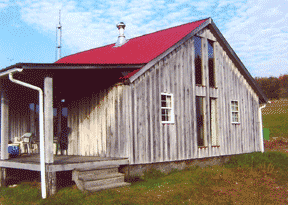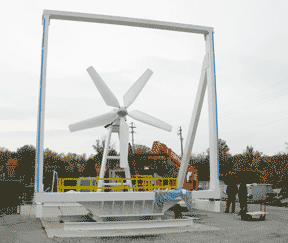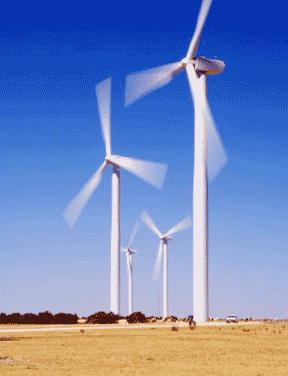|
|||||||||
Putting the
|
|||||||||
 |
Maryland doesn’t have the most terrific wind, but we have potential to take advantage of some good pockets.–Crissy Godfrey, Maryland Energy Administration wind expert |
Autrey didn’t give up on wind power. He next purchased a 50-foot Whisper H 40 for $1,500 and installed it on a sloping hillside about 200 feet from his cabin. Guy-wires steady the pole, and underground wires conduct electricity to storage batteries and to the cabin. The 900-watt system is enough to run his sump pump, fluorescent lights, a ceiling fan and his wife’s hairdryer.
As well as an amateur inventor, Autrey is a professional electrician. He wired his new turbine to an elaborate 12-battery system that charges while the turbine spins. He also designed a warming system to keep the batteries above freezing in the frigid West Virginia winters.
Small is Beautiful
Like Goliath, towering turbines — such as the ones US Wind force would install — have the advantage of sheer size and strength. The 400-foot towers generate electricity measured in megawatts that could be sold on the grid system. But like David, small size is an advantage for homes and other individual sites.
Rather than add their power to the grid, small windmills power specific buildings or purposes. Unlike the giants, which typically look alike, small windmills come in three styles: The horizontal version rotates like a pinwheel, as we expect a windmill should. The vertical model spins like a barber shop spiral. The Darius — a European model that hasn’t yet caught on on this continent — looks like a single eggbeater.
With small, individualized energy sources, “you’re taking the future into your own hands in terms of electricity needs,” says Godfrey, of the state Energy Administration.
Smaller windmills also allay the aesthetic argument. “Some people find the small scale more appealing,” Godfrey says, “because small turbines are shorter and not as visible as the large turbines.”
The 400-foot gargantuans produce 1.65 megawatts, whereas tinier turbines — typically under 100 feet — produce smaller, individualized amounts of energy. Small-scale wind is considered less than 100 kilowatts, but wind units can be as small as 50 watts.
“A 50-watt unit is not going to do too much,” Godfrey says. A typical home uses about 10,000 kilowatt-hours of electricity per year. “To put a dent in your home electric bill,” she explains, “you’d need at least a one-kilowatt system.”
Small wind projects have another advantage of size: They elude problems and complaints generated by giant turbines.
The towering turbines that Maryland officials are pondering make constant noise in the 50- to 60-decibel range — comparable to the inside of a quiet car or a conversation three feet away. Autrey says his small windmill makes little noise when it’s spinning in the average 15 to 17 mile-an-hour winds that blow at his cabin.
“When the wind gusts up to 70 to 100 miles per hour, then you can hear it,” he says. Even so, he says it’s not a nuisance.
Wildlife advocates are concerned about the numbers of migrating birds and bats killed by the 35- to 40-foot spans on the giant turbines. Smaller wind turbines don’t snag as many fliers. To Autrey’s knowledge, his seven-foot-diameter turbine has not slain any bats or birds. Manufacturers of vertical-style turbines claim that their systems are more bird-friendly because they spin like tops, appearing as solid objects.
On small turbines, birds may even nest in the lattice towers, which have criss-crossing supports like radio towers. No birds colonize Autrey’s; his propeller sits atop a pole that’s far skinnier than those giant turbine poles.
Small has still another virtue: You can do it yourself.
Catching the Wind
Maryland is behind, Godfrey says, in two ways.
First, we’re not the windiest state.
“We don’t have the most terrific resources, but we have potential to take advantage of some good wind pockets,” she says.
Second, we haven’t capitalized on what wind we have. Windy states out west operate enormous wind farms, while Maryland has four proposed wind farms — but none yet built. A dozen or two wind-seekers call Maryland Energy Administration each week to find out how to catch the wind. Inquiries come mostly from Eastern Shore homeowners and farmers, but also from residents statewide.
Maryland hotspots for wind include the Eastern Shore, Frederick, Garrett and Carroll counties. Breezes die down mid-state: a site in calm Prince George’s county sought wind energy, “and I had to tell them they’ve got nothing. It’s not going to work,” Godfrey says.
For others, a turbine may be the ticket to energy independence. If you think promising winds are blowing on your land, you’ll have to do your homework before you buy. But you don’t have to pioneer alone.
The Maryland Energy Administration is eager to help property owners seeking renewable energy sources. They’ll even help a wind energy pioneer pay for the initial investment.
A typical one-and-a-half-kilowatt system — enough to put a dent in your home electric bill — costs about $15,000, including installation. That’s among the cheaper systems that will power your home. A 10-kilowatt system costs some $55,000 installed.
“People hear the number and think that’s a lot of money,” Godfrey says. “But what you’re buying is your power for 20 to 25 years all in one lump sum.”
To help defray those alternative energy costs, Maryland Energy Administration began offering grants in November. They’ll reimburse a buyer $1,500 per kilowatt on the (at least one-kilowatt) system: up to $3,000 for individual residences and up to $5,000 for non-residential sites, including farms, businesses and local governments.
Since November, Maryland Energy Administration has made five grants totaling $13,500: four at private residences and one at Crisfield High School. Godfrey’s almost out of the allotted $15,000 in grant money, but she expects more grant money for more small wind projects.
Small wind energy grants are about a year and a half behind the state’s growing solar and geothermal grant program, which budgets $675,000 for both alternative energy projects. “We have to prove our worth in a new field,” Godfrey says.
Once your turbine starts spinning, the Clean Energy Production Tax Credit offers even more financial reward. Since 2006, landowners who generate their own power with renewable energy can claim an income tax credit of 85 cents per kilowatt-hour.
 |
At Bill Autrey’s West Virginia cabin, he powers a sump pump, fluorescent lights, a ceiling fan and his wife’s hairdryer with a 50-foot-high, 900-watt windmill. |
 |
Maryland hopes such incentives will convince you to look into wind energy for your own home or business.
Harnessing the Wind
Besides financial aid, Maryland Energy Administration helps homeowners figure out the steps from power plant grid to self-sufficient turbine. Small Wind Electric Systems is a crash-course booklet published by the state to get you started.
First, figure out your wind resources. To make a turbine worth the investment, you need steady winds to propel your system. State wind maps can help determine if strong, steady winds blow across your property. Godfrey will reference a detailed map, and Maryland Department of Energy will lend you either its 164-foot-tall anemometer or its 99-foot-tall anemometer for a year to monitor wind speeds in all seasons. The wait list, however, is a year. Getting a private company to test your average wind speed costs up to $7,500.
Sometimes, finding the wind means going up. Obstructions within a 300-foot radius around your planned site — like trees or buildings — cause wind turbulence, so a turbine must rise at least 20 feet above such obstructions.
A hundred feet in the air or down at the ground, predicting wind isn’t easy, but to make sense of Maryland wind patterns, the U.S. Department of Energy has tracked average wind speeds across the state. Wind speeds are measured in seven classes. Most of Maryland is Class One, averaging less than 10 miles per hour. Class Two, or marginal, wind speeds (10 to 111⁄2 miles per hour), are “the true threshold for economic feasibility,” says Godfrey, meaning you’ll see some payback for your investment. The wind turbine will pay for itself someday if you get about 12 miles per hour.
hour.
Twelve miles per hour is typical throughout windier parts of the state, especially on the Eastern Shore and in Western Maryland. Over Bay waters, winds blow upward of 13 miles per hour; some sailors take advantage of the winds and install mini-turbines on their masts to help cover electricity needs.
The Chesapeake’s steady breezes are still calm compared to western states surrounding the Rocky Mountains, where winds whip up into Class Five or Six (averaging 15 miles per hour). The Alaskan peninsula and the Aleutian Islands are the windiest part of the country, scoured by Class Seven winds (up to 21 miles per hour).
Once you know you have the right wind speeds, the second step is to decide how much of your power you want to generate yourself, and how much you’ll still pay for from the grid.
“Some people don’t care about economic payback. They do it for environmental reasons or maybe they want to be more independent,” says Godfrey, who helps both landowners who want to cover a percentage of their electricity and those who want to generate 100 percent of their power. By cutting your energy usage and becoming more energy efficient, you’ll slash the amount of power you need to generate in the first place.
One wind-power hopeful learned that the 10-kilowatt wind turbine she was considering wouldn’t make a dent in the 30,000 kilowatt hours she consumed each year. To make her investment pay off, Godfrey advised her to reduce her home’s energy usage to under 13,000 kilowatt hours annually.
Autrey knew he’d need to generate all of his power; connecting to a power plant grid wasn’t an affordable option at his rural site. He built with an eye to keeping his energy usage at a minimum.
Third, you’ll need permission from your local government.
“Permitting and zoning is probably the biggest hurdle,” Godfrey says, for getting a wind system in place. That’s because each county has its own rules for issuing permits and zoning for wind turbines, which typically require a building permit and an electrical permit.
Rules may get friendlier as clean energy gets more state support.
Maryland is now taking small steps. To show citizens just how feasible small wind projects — and other alternatives — can be, Gov. Martin O’Malley’s Clean Energy Schools initiative seeks to install one renewable energy demonstration project in each county by June.
The first renewable project — a 1.8-kilowatt wind turbine at Crisfield High School — is under construction in Somerset County.
Letting Marylanders know how feasible small wind energy is isn’t just a novelty for a state facing blackouts in four years. It’s a necessity.
 |
The Wind Cube, shown here without its funnel-like shroud, looks like a giant box fan and generates some 175 kilowatts per year, enough electricity to power about 10 3,000-square-foot homes. Currently, only one unit, at a small manufacturing facility in Cleveland, is online. |
Boxing in the Wind
If necessity breeds invention, the growing potential of wind power makes the inventor creative. Since Henry Ford built the Model T, companies have jumped ahead to create automobiles from Hummers to Smart Cars, from electric cars to race cars. Like cars, new models of small wind systems are cropping up.
In Ohio, one energy company made a powerful wind system that doesn’t need the space or wind speeds of traditional turbines.
“The Wind Cube is a hybrid. It’s a horizontal type but instead of being on a tower, it’s encased in a cube,” explains the Energy Administration’s Godfrey.
The Wind Cube looks like a box fan, like city dwellers might put in their windows, but much, much bigger. Local entrepreneur Dwain Kinsinger is trying to bring Wind Cubes to Maryland.
Based on the mainstream horizontal turbine, this technology is so new that only one Wind Cube now spins. That first system, running in Cleveland, powers a small manufacturing facility. In April, the company will move it and another new cube to a Pennsylvania coalmine to capture wind coming from the shafts. A second system will soon power the 41-story justice building in downtown Cleveland.
After June, Kinsinger, CEO of Green Energy Technologies of Maryland, expects three to four per month to go online.
The cubes will need much less foot room than the giant turbines with their two-acre footprints. Kinsinger’s cube has an eight-by-10-foot footprint below the actual cube, which measures 22 feet high and wide, and 15 feet deep. That’s smaller even than little turbines, which need a 300-foot radius of space. The cubes have another space-saving grace: Unlike open turbines, these boxed units can be stacked or perch on a pedestal for maximum space usage.
Stacked, the cubes gain strength in numbers: eight cubes would produce 1.6 megawatts, rivaling one of the gargantuan pole-mounted windmills. This new invention delivers a power-filled punch because of physics: Airflow is forced through a funnel, speeding the wind flow to the turbine, so the turbine will start spinning at speeds as low as four and a half miles per hour.
So for a site that averages wind speeds of 12 miles per hour each year, “for the Wind Cube, that’s 25 miles per hour,” Kinsinger explains. Under those conditions, his Wind Cube generates some 175,000 kilowatts per year, or enough power to run about 10 3,000-square-foot homes.
Like other small wind turbines, Wind Cubes are quiet, emitting some 30 decibels at 30 feet, or about as quiet as a library. To keep birds and bats from harm’s way, “the cube can be enclosed in wire mesh; wind goes thru but birds cannot,” Kinsinger says.
Cost makes these small wind units a serious investment. A homeowner might be able to afford a small wind turbine, starting at $15,000. At $265,000 plus $50,000 to $100,000 for installation, these cubes are out of most homeowners’ reach.
Instead of homes, these boxes will power big buildings, businesses and universities. Kinsinger’s company is courting the state, seeking to help Maryland reach its 9.5-percent renewable commitment by putting Wind Cubes on state lands.
“We think we’re going to sell a lot of these to put on places like water treatment plants, waste management sites and around nuclear power plants,” he says.
Like tall buildings, bridges are another location he dreams of. “We could hang these under the Bay Bridge, where we have constant wind,” he says. “We’d generate an unbelievable amount of wind energy.”
The Wind is Kicking Up
“Wind technology has been around a long time, but new variations are coming out every year,” says Crissy Godfrey, whose job is selling wind to Marylanders. Wind Cubes are just one of the ways entrepreneurs seek to harness the wind.
Such projects gain speed as governments around the country try to balance swelling energy demand with curbing pollution and cutting back on coal-fired power.
“Wind energy in the appropriate places,” she says, “is just one part of the solution to our energy situation.”
For Autrey, wind has been the ideal solution. His turbine has been powering his weekend retreat most of this century. More wind power might be harnessed if homeowners knew how easy it was.
“There are a lot of people out there who want to know, but they don’t know who to talk to or who to contact,” says Autrey, who had dozens of strangers emailing after Backhome magazine published a story on his cabin. “They don’t know how to sit down and figure out a system and install it into their home.”
Wind might — or might not — be your ideal solution for clean energy. But where the winds blow in Maryland, small windmills might gain more allies than the giant sky-scraping turbines the state is pondering.
To find out more, visit www.energy.state.md.us.
If you enjoyed this story check out:
http://www.bayweekly.com/old-site/year07/issuexv16/leadxv16_1.html
|
Current Issue \\ Archives \\ Clasified Advertising \\ Display Advertising |
 Volume 16, Issue 11 - March 13 - 19, 2008
Volume 16, Issue 11 - March 13 - 19, 2008
 Wind to
Wind to